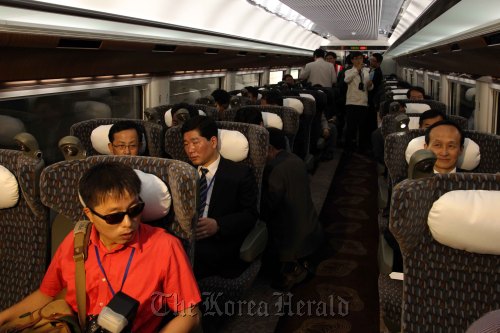
Traveling time from Seoul to Busan to be cut to one-and-a-half hours by 2015
CHANGWON, South Gyeongsang Province ― Korea’s new high-speed train HEMU-430X showed its long, navy nose to the public for the first time in this southeastern city of Changwon on Wednesday.
The faster and bigger successor to the KTX-Sancheon is the nation’s second bullet train developed with local technologies and its production has been carried out in the city by Hyundai Rotem, the train maker.
The HEMU, short for High-speed Electric Multiple Unit, is also the nation’s first high-speed train driven not by end cars but engines uniformly distributed under the individual coaches.
The advanced prototype increases space for passengers by 16 percent compared to existing KTX trains and enhances the train’s performance overall, according to the Ministry of Land, Transport and Maritime Affairs.
As a result, the HEMU can carry up to 456 passengers at a speed of 370 kilometers an hour, which is 70 kilometers per hour faster than its predecessor, the KTX, which carries 363 people.
With commercial operation set to begin as early as 2015, it will take only an hour and a half for the train to connect the 450 kilometer stretch from between Seoul and Busan.
CHANGWON, South Gyeongsang Province ― Korea’s new high-speed train HEMU-430X showed its long, navy nose to the public for the first time in this southeastern city of Changwon on Wednesday.
The faster and bigger successor to the KTX-Sancheon is the nation’s second bullet train developed with local technologies and its production has been carried out in the city by Hyundai Rotem, the train maker.
The HEMU, short for High-speed Electric Multiple Unit, is also the nation’s first high-speed train driven not by end cars but engines uniformly distributed under the individual coaches.
The advanced prototype increases space for passengers by 16 percent compared to existing KTX trains and enhances the train’s performance overall, according to the Ministry of Land, Transport and Maritime Affairs.
As a result, the HEMU can carry up to 456 passengers at a speed of 370 kilometers an hour, which is 70 kilometers per hour faster than its predecessor, the KTX, which carries 363 people.
With commercial operation set to begin as early as 2015, it will take only an hour and a half for the train to connect the 450 kilometer stretch from between Seoul and Busan.


Currently, the KTX rail journey from the capital to the southernmost port city takes two hours and 25 minutes.
“Now Korea has become a large city, with the HEMU connecting Seoul and Busan just in one and a half hours,” Land Minister Kwon Do-yeop said at a ceremony unveiling the new high-speed train.
“Countries like China and Japan are stepping up efforts to develop a high-speed train. We have taken one step closer to dominating the 250 trillion won ($210 billion) global market.”
After introducing the French high-speed train KTX in 2004, Korea succeeded in developing and operating its own train KTX-Sancheon in 2010, becoming the fourth nation to do so after France, Germany and Japan.
For the Hemu project, the government spent five years since 2007 and 93.1 billion won, with the participation of 52 organizations such as Korea Railroad Research Institute and Hyundai Rotem, the heavy industry unit of Hyundai Motor.
The ministry said that about 83.7 percent of the Menu was produced with local science, while some components were imported due to economic benefits.
On Wednesday, guests and reporters were allowed to be onboard the train that traveled 28.2 kilometers between Changwon and Jinyoung at 150 kilometers per hour.
The interior design of the train embraces more modern ambiance than KTX trains, while the IT system has been upgraded to offer travel schedule, Web searching and video-on-demand services.
After being moved to Busan, the train will undergo a through inspection in the coming months with some 800 sensors on it checking if any defect occurs while traveling.
The speed test is also planned to be carried out in phases. The ministry expected that the 430 kilometer per hour drive can be demonstrated within the first half of the year.
The announcement came after the Board of Audit and Inspection found last month that the KTX-Sancheon began commercial operations without enough safety checkups.
The state-run agency said it also spotted sloppy maintenance of parts, repairs, human resources training and overall safety measures, which it said led to a surge in accidents but no casualties.
“We fully understand the safety concern of people. But now we have enough experience and data. We will secure the train’s safety through thorough inspection,” said Mok Jin-yong, director general of the Korea Railroad Research Institute.
By Lee Ji-yoon (jylee@heraldcorp.com)
-
Articles by Korea Herald





![[Graphic News] Beer the most favored alcoholic drink by Koreans](http://res.heraldm.com/phpwas/restmb_idxmake.php?idx=644&simg=/content/image/2024/05/09/20240509050765_0.gif&u=)








![[Weekender] Pet food makers bet big on ‘recession-free’ pet food market](http://res.heraldm.com/phpwas/restmb_idxmake.php?idx=652&simg=/content/image/2024/05/10/20240510050754_0.jpg&u=20240511163252)




![[What to play] Musical tributes to family in the month of family](http://res.heraldm.com/phpwas/restmb_idxmake.php?idx=642&simg=/content/image/2024/05/09/20240509050795_0.jpg&u=)